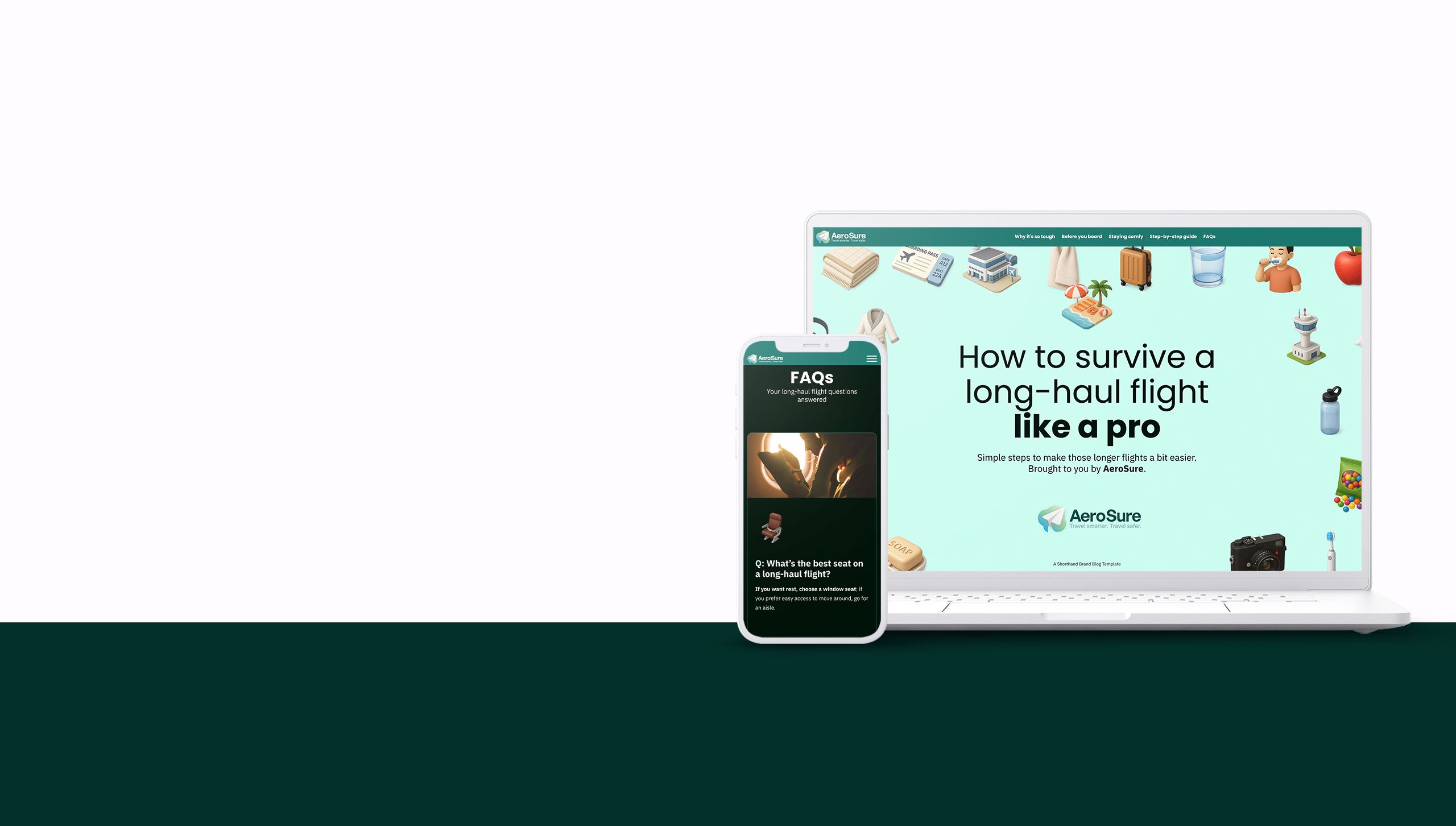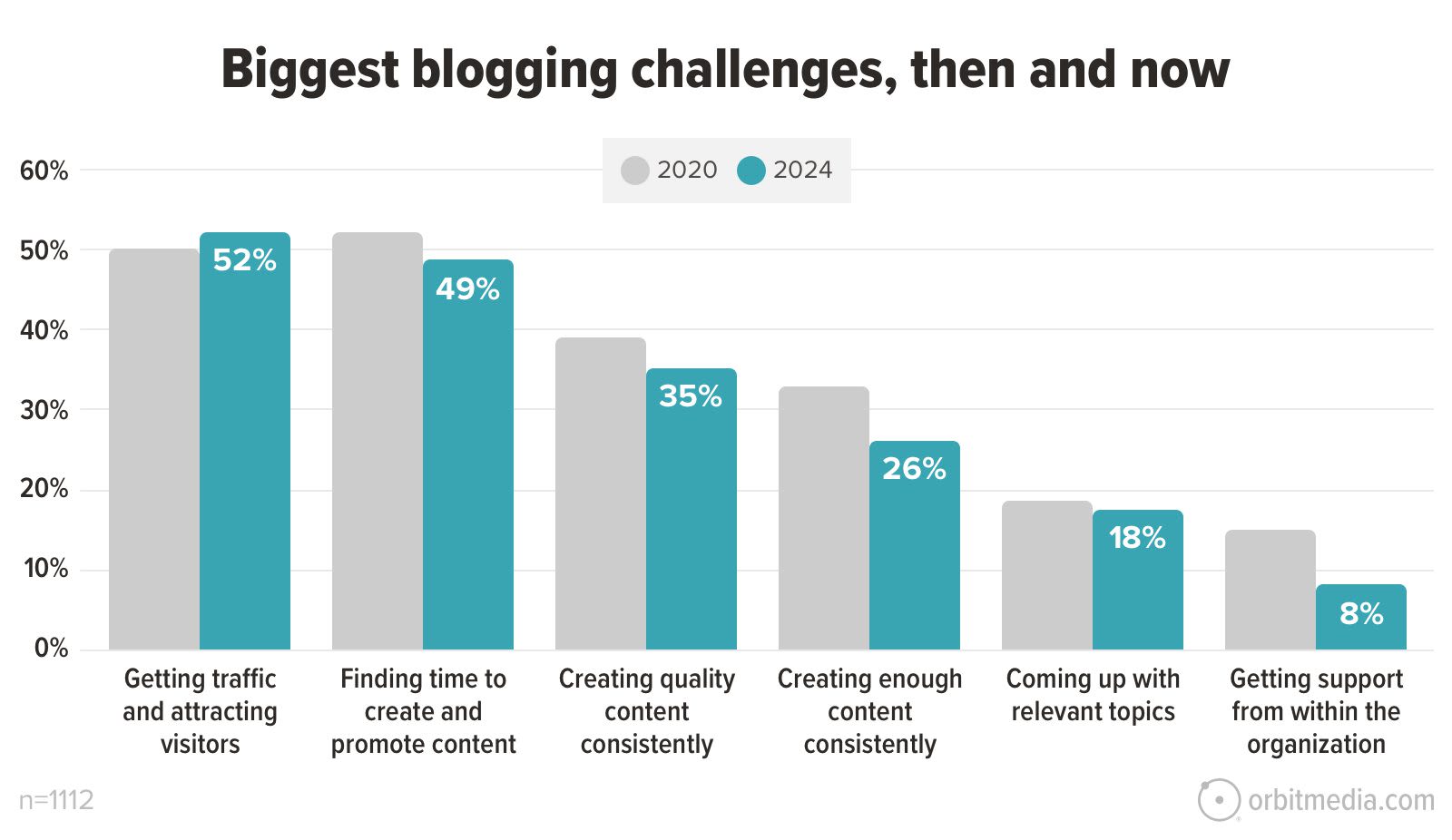Brand blogs aren’t dead, but maybe yours is flatlining

We’re not the first to ponder the relevance of business blogging, and we won’t be the last. Here’s our detailed take, with new analysis, tactics, and examples to help make sure yours is alive and thriving.
foreword by Tim King
foreword by Tim King
Look, nobody needs another limp ‘blogging is dead’ obituary.
It’s not dead. But yours might as well be on life support.
Most business blogs are flatter than a pint of beer left out in the sun. Full of corporate waffle, and blander than the phrase ‘thought leadership’ (which makes drying paint look like a spectator sport).
Here’s the truth. Blogs are still one of the most savage weapons in your marketing arsenal, if you’ve got the guts to wield them properly.
What’s changed? Absolutely everything. Audience expectations, Google’s AI tantrum, the lot.
No one has time for endless beige paragraphs. You want attention? Tell a damn story, use great visuals, and make your content move.
If it reads like keyword-stuffed search engine bait then you’re just giving people a reason to ignore your blog faster than a doom-scrolling teenager with a TikTok obsession.
And don’t kid yourself, you can’t ignore the AI Search arms race. If you’re not adapting, you’re invisible.
Stop hiding behind ‘safe’ copy and start giving your audience something worth a damn.
Otherwise, enjoy shouting into the void.
Welcome to the new era of brand blogging. Sink or swim.
Start creating with Shorthand
It's the fastest way to publish beautifully engaging brand blogs, digital mags, internal comms, and more.
Blogs: very much alive

Blogs are absolutely relevant, and businesses still invest in blogging for a number of reasons, such as brand awareness, customer engagement, lead generation, SEO, and thought leadership.
It’s true that blogs in the traditional sense — article entries from individuals and brands sharing their stories with copy and images — face threats from changing audience behaviour, Google algorithm changes, AI search, social media, and shortform video content.
50% of blogging marketers' ROI increased in 2024
But the benefits are still too great to ignore for many marketers, who continue to invest heavily in their blogs.
How brand blogs are performing
Hubspot’s 2025 State of Blogging Report surveyed more than 500 marketers, 65% of whom are employed by companies that maintain blogs. Of those, 93% cite blogging as being important or very important to their broader marketing strategies. In addition:
- 50% saw a higher ROI from blogging in 2024, relative to 2023
- 31% said ROI was roughly the same
- 45% plan to invest more budget in blogging than in 2024
As far as marketing teams are concerned, then, blogging is very much alive. What are their goals?
- 66% of blogging companies in Hubspot’s report publish content for brand awareness
- 53% for customer engagement
- 49% for lead generation
- 34% for SEO
- 26% for thought leadership
So, the marketers are sold.
But there’s no doubt about it, blogging is getting harder. Orbitmedia research found that driving traffic is the number one challenge for bloggers. And that is down to a drop in search referrals. “Google is much better at keeping their visitors, so organic traffic is down.”
As we’ll see, there are a number of ways brand blogs can prepare for this change and make it work to their advantage.
Is a business blog right for your brand?

This depends on:
- your content marketing goals
- your audience
- your resources
Maybe you’ve been blogging for quite some time and it’s all starting to feel a little tired (or dead). Or maybe you’re considering starting a blog and unsure it’s the right call.
After all, there have never been more options and avenues to choose from when it comes to spending your content marketing resources and budget. At Shorthand, we killed our blog, in favour of a digital magazine (though one could argue that in our case the difference is nominal).
What are your goals?
Think through your blogging goals, measured against some hard content marketing metrics; this could deliver the reality check you need.
Analyse your target audience, where they are and how they consume content, then weigh it all up against other marketing avenues like social media or video — but also keep in mind that good blogs these days often include video and social media content.
Test your blog’s performance
Consider testing, like preparing some multimedia content within your blog and comparing how this performs against your more static posts.
Weigh up the pros and cons of blogging
The good news is many of the same blogging ‘pros’ as before still apply. Blogs enhance engagement, build connections with your audience, are fantastic for building a newsletter list and social media following, are great for SEO, establish authority, and can generate leads.
Still, it’s worth weighing up the advantages and disadvantages: how would the same budget and time perform if instead applied to a social media push, video, advertising, or a combination?
Once again, a detailed understanding of the habits and preferences of your target audience should drive your decision.
Create a more immersive version of your blog with Shorthand
Here’s what works in blogging today
Better storytelling
Storytelling helps turn blog content into something readers want to connect with.
When marketers talk about building communities, fostering engagement, and brand recall, you can trace it all back to a brand’s story. Blogs are a proven method here.
When we talk about ‘cutting through the noise’, or ‘hooking’ our audience’s attention, it sounds like we’re trying to ‘trick’ potential readers into connecting with our content. That leaves out some truth: people actually want to be entertained, informed, inspired, distracted, or spoken to.
In a Prezi study, 55% of people said a great story captures their focus and keeps them engaged.
In Forbes, Heather V MacArthur cites research that found when people hear a story, neurons in the brain fire in the same pattern as the speaker’s, a process known as ‘neural coupling’ or ‘mirroring’. This produces dopamine, leading us to anticipate the story’s resolution and remember something with greater accuracy.
It’s not all about huddling around the campfire and spinning a good yarn, though.
Today there are tools and real tactics to bring best practice digital storytelling to your content and brand blog. Depending on your budget, these could include investment in writing, design, video production, or a better digital publishing platform.
That brings us to the next point:
Multimedia storytelling
Including multimedia elements like video, audio, images, and scrollytelling, can:
- increase engagement and time-on-page
- improve SEO rankings
- improve brand recall
Multimedia storytelling can deliver enhanced engagement and have the benefit of helping you diversify your content mix with plenty of material for repurposing.
Brand bloggers know that media consumption habits are changing, and plenty of competition from audio, social media, shortform video, and more, can pose a threat to blog traffic and engagement.
But today’s best digital publishing platforms let you cater to these trends right within the pages of your blog.
Shorthand’s own research makes the case for this: our analysis of more than 54,000 stories published over a 12-month period — many of them blogs — shows that top performers used more interactive media elements like scrollytelling, media galleries, and Text Over Media.
Repurposing video, audio, and text can get content marketers closer to their goals. Marketers in Hubspot’s blogging report understand this, with 81% also investing in video, 53% in podcasts, 46% in newsletters, and 39% in webinars.
In addition to making your blog more engaging, a healthy media mix can future proof your content marketing by providing you with plenty of material to repurpose and hit the right audience, on the right device, at the right time.
Content design
Content design is the business of understanding your reader and structuring your material to meet their needs quickly and clearly. In the era of the instant click-away, it’s more important than ever.
Some say content design is even more important than content quality. We think it's possible to deliver both, and that both are in fact necessary for a successful blog.
Previous reporting puts the ‘sweet spot’ article length between 1500-4000 words for maximum engagement. But just because we know that longform content performs well, doesn’t mean it’s time to go out and publish lines upon lines of never ending copy.
With readers fast to disengage, it’s time to make sure the core of your message is delivered early and with impact. The intended message, hook, CTA, or goal of your storytelling should be clearly signposted.
Do your research
Better content design can deliver in droves here. It starts with research. Your business blog should reflect your detailed understanding of your audience, with material that has the structure, language, length, media, and emotion to satisfy them. It’s an ongoing and iterative process.
How content design works
As outlined by content strategist Sarah Winters, here’s the process:
- Research: What is your audience coming to your blog for? What are their wants and needs? How much time do they have? What device are they likely to be on?
- User needs: Define the user need that your blog satisfies. Work to solve this need, and “don’t chase traffic.” Focus on “fewer but more valuable, more successful interactions with our audience.”
- Journey and channel mapping: Ensure you have an understanding of the journey readers take to get to your content. Apply a consistent message in the right way to the channels they encounter on this journey.
- Language and emotion: The language you use must reflect your audience’s vocabulary, “Otherwise, they may find the interaction too difficult and abandon it”, Winter says. Similarly, emotion must inform the tone, help connect with the audience, and inform their journey.
“We don’t use language for search engines — we use it for the humans behind those engines. We don’t pull people into useless pages or manipulate. We help people.”
Iterate and tweak
With the above level of understanding, content teams can create and optimise content that suits the need, journey, and emotion of the audience. It’s a collaborative process between stakeholders that must always keep the consumer's needs at its heart.
And it’s an iterative process — tweaks and changes should be tested and optimised over time (don’t forget, your audience and its needs and journey will change, too).



You must understand how SEO is changing
The age of keyword stuffing and backlinks for high traffic is over. SEO is still vitally important, but keywords and backlinks now fit into a growing list of priorities and requirements.
If traffic is your number one goal, it might be time for a re-think.
Zero-click search results are increasing their share of search user journeys, and show no signs of slowing down. These pose a threat to traffic.
Datos research found that in March 2025, 13% of all Google search queries resulted in AI Overviews. This was double the result for January.
What is AI surfacing in search?
The vast majority of AI Overview results are for informational queries; think top-of-funnel, fast answers for straightforward questions. Searches that may include more intent driven keywords aren’t returning AI Overviews results yet. After all, these are still a revenue stream for Google, through things like Google Ads and paid search. The search behemoth isn't likely to cannibalise these for now.
In a video interview with the Content Marketing Institute, Belinda Conde, Senior VP of marketing at Datos, was quick to reassure content marketers, many of whom fear some sort of ‘post-click’ search world.
SEO is still important
“The good news,” Conde says, is that traditional SEO best practices “are still, very much, super important in the AI Overviews world.”
Conde calls it “overlap” between tactics for both.
Datos’ research shows that 52% of AI Overview results are citing sources that were already ranking within the top 10. So all that effort invested into SEO isn’t thrown out with the arrival of the hot new thing; it can be put to work to help appear in AI Overviews too.
How to optimise for AI Overview search results:
- optimise for longer-tail keywords
- answer queries in the first paragraph
- use a concise answer
“Right now is a specific moment in time where brands have a huge opportunity to organically win those AI mentions.”
“You want to have a very concise, straight answer that the AI can then scrape and then pretty much copy paste into their own AI Overview results,” adds Conde. She also says FAQ content, how-to articles, and bullet-points are all high achievers
“Make it as easy as possible for the AI or LLM to understand your content and you’ll have higher chances of actually getting cited.”
But be quick
Conde says this “specific moment in time” presents a great opportunity. “Consumers still see any output that AI gives them as very reliable sources of information.
“The moment that we start seeing ads within AI platforms, or the moment that we start seeing sponsored results in ChatGPT outputs? I don’t think that perception is going to last very long.”


What types of blogs work well in 2025?

Modern blogs should prioritise offering value to readers, and satisfying their need quickly and clearly. The benefits of providing this type of material are twofold: they will increase your chances of engaging with timepoor audiences, but will also cater better to Google AI Overview and ChatGPT search results.
In Datos’ research, content types that performed strongly were “very well-structured content, FAQs, how-tos,” says Conde.
The multimedia element is also important: “Increasing video is always a great idea, for AI specifically, or just for organic engagement.”
In Orbitmedia’s research, the ‘most effective’ blog content types were:
1. Roundups: 28% of bloggers reported ‘strong results’
2. Original research and infographics, both on 25%
3. Interviews, webinars, and guides and ebooks, on 24%
What about industries?
Datos’ research found that science, health, people, society, law, and government were the most affected industries by AI Overviews.
News, sports, and more timely topics were less affected. “Having AI Overview pull something in relation to news and sports and something very timely could run the risk of providing inaccurate information pulling from outdated sources,” says Conde.
So blogs that demand and sustain a higher publishing frequency should aim to prioritise accuracy and volume, while ones with slower cycles, and more evergreen content, can add AI search to their list of things to optimise.
Three fantastic modern blog examples

IKEA Stories
IKEA’s Stories is a branded, magazine-style content marketing platform. It invites scrolling with its immersive, accessible, and entertaining style. It leans on multimedia storytelling to make longer passages more readable.
Its editorial storytelling usually focuses on customers and their homes, though sometimes corporate communications, featuring IKEA employees and internal projects, are showcased too.
Thus it is a hybrid, with external (audience growth, engagement, branding) and internal (purpose, and innovation showcased to employees and stakeholders) goals.
RELX: Perspectives
Perspectives compiles a range of engaging and informative stories.
Some tout its partnerships with conservation programs, others explore the experience of its workforce. More general stories also offer value to a broader professional audience, with examples including articles about work life balance and spotting online fraud.
In Don’t be a mule, LexisNexis Risk Solutions, RELX's risk management arm, explores how Metro Bank uncovered mule accounts and increased its detection rates. The story has a dynamic title section followed by a full-width video. Multimedia elements continue throughout, as scrolling reveals present visual data representations and infographics. It’s a case study that combines text based storytelling with the elements we know will perform, such as rich multimedia, and brief, informative answer and advice sections.
University of Oregon: OregonNews
The University of Oregon’s news hub is a vast source of updates on student life, new research, staff announcements, and more. It contains written articles, immersive stories, and podcasts.
Sibling scientists and their dog hunt for Oregon’s hidden truffle biodiversity is the story of UO students Hilary Rose and Heather Dawson and their truffle dog, Rye. After a brief introduction it launches into a full-width video of Dawson and Rye out in the field seeking truffles. The video’s cinematic production value makes it a joy to watch, no doubt boosting engagement and time on page.
After more body text with supporting imagery, links to other resources, and pullquotes, the article includes a longer, embedded YouTube video that contains audio of Heather explaining her work and its importance. It’s a great example of repurposing — one teaser, mute video to build atmosphere, with an audio version down below for readers who’ve completed the article and want to get the full experience.
Your brand blog: where to from here?

Business blogs are still reaping dividends for content marketing teams, and are worth the investment. But changing digital publishing and search landscapes mean some future proofing is in order.
Make sure you:
- Deliver real value to your audience — don't just harvest their clicks with SEO-stuffed copy.
- Get better at storytelling. It’s at the heart of any successful content play, including your brand blog.
- Apply a content designer’s level of care and attention to your audience and the product you serve them.
- Invest in multimedia storytelling, both to boost engagement on your own blog, and to feed a repurposed content pipeline for other platforms.
- Add AI search best practices to your existing SEO work.
- Interrogate your content marketing goals and ensure your blog is geared to them.
This free brand blog template is a modern, animated scroll with an optimised layout for SEO and AEO performance.




